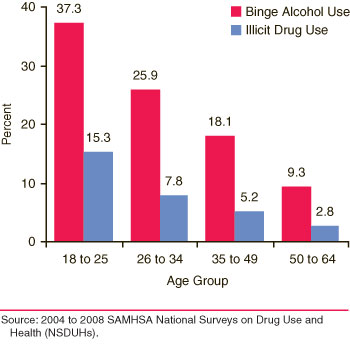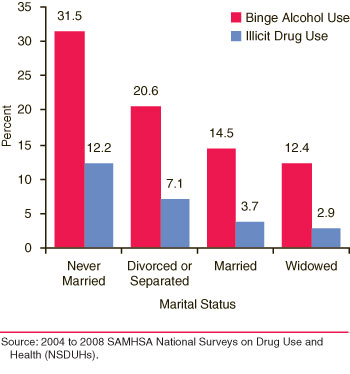
 |
| July 22, 2010 |
|
Almost 50 million women aged 18 to 64 (53.4 percent of women in that age group) were employed full time during the week before the survey interview (Table 1). Full-time employment varied by age, race/ethnicity, marital status, and whether or not women lived with a child aged 17 or younger.
| Characteristic | Number Employed Full Time (in 1,000s) |
Percent of Population |
|---|---|---|
| Total | 49,948 | 53.4% |
| Aged 18 to 25 | 6,560 | 40.5% |
| Aged 26 to 34 | 10,100 | 57.2% |
| Aged 35 to 49 | 19,844 | 60.1% |
| Aged 50 to 64 | 13,444 | 50.3% |
| White | 33,544 | 53.5% |
| Black or African American | 7,055 | 58.5% |
| American Indian or Alaska Native | 241 | 48.2% |
| Native Hawaiian or Other Pacific Islander | 183 | 54.6% |
| Asian | 2,294 | 52.7% |
| Two or More Races | 530 | 50.8% |
| Hispanic or Latino | 6,101 | 48.3% |
| Married | 27,018 | 52.0% |
| Widowed | 1,221 | 44.9% |
| Divorced/Separated | 9,233 | 63.9% |
| Never Married | 12,476 | 50.9% |
| Living with a Child Aged 17 or Younger* | 20,494 | 51.5% |
| Not Living with a Child Aged 17 or Younger | 29,397 | 54.8% |
| * Respondents with missing data on the number of children have been excluded from the analysis. Source: 2004 to 2008 SAMHSA National Surveys on Drug Use and Health (NSDUHs). |
Combined data from 2004 to 2008 indicate that 19.8 percent of women aged 18 to 64 who were employed full time engaged in binge alcohol use and 6.4 percent used illicit drugs in the past month; this translates into 9.9 million binging on alcohol and 3.2 million using illicit drugs.7 However, rates of substance use varied by demographic characteristics. The rates of past month binge alcohol use and illicit drug use among women employed full time decreased with age (Figure 1). For example, nearly two fifths (37.3 percent) of women aged 18 to 25 who were employed full time reported past month binge alcohol use compared with 25.9 percent of those aged 26 to 34, 18.1 percent of those aged 35 to 49, and 9.3 percent of those aged 50 to 64.
 |
| Age Group | Binge Alcohol Use |
Illicit Drug Use |
|---|---|---|
| 18 to 25 | 37.3% | 15.3% |
| 26 to 34 | 25.9% | 7.8% |
| 35 to 49 | 18.1% | 5.2% |
| 50 to 64 | 9.3% | 2.8% |
| Source: 2004 to 2008 SAMHSA National Surveys on Drug Use and Health (NSDUHs). |
Rates of substance use also varied by race/ethnicity (Figure 2). Among women employed full time, the rate of binge alcohol use ranged from 28.2 percent among American Indians or Alaska Natives to 8.0 percent among Asians. The rate of past month illicit drug use ranged from 10.4 percent among women of two or more races who were employed full time to 2.5 percent of their Asian counterparts.
 |
| Race/Ethnicity | Binge Alcohol Use |
Illicit Drug Use |
|---|---|---|
| American Indian or Alaska Native | 28.2% | 6.8% |
| White | 21.8% | 7.1% |
| Two or More Races | 19.7% | 10.4% |
| Hispanic | 18.0% | 4.9% |
| Black | 15.8% | 5.4% |
| Asian | 8.0% | 2.5% |
| Source: 2004 to 2008 SAMHSA National Surveys on Drug Use and Health (NSDUHs). |
Rates of substance use among women employed full time varied by marital status, with those who were never married having the highest rates (Figure 3). For example, 31.5 percent of those who were never married indicated past month binge alcohol use compared with 20.6 percent of those who were divorced or separated, 14.5 percent of those who were married, and 12.4 percent of those who were widowed. In assessing these differences, it should be noted that marital status varies by age. For example, among full-time employed women, most of those who were never married (69.9 percent) were aged 18 to 34, while most of those who were married (76.3 percent) were aged 35 to 64.
 |
| Marital Status | Binge Alcohol Use |
Illicit Drug Use |
|---|---|---|
| Never Married | 31.5% | 12.2% |
| Divorced or Separated | 20.6% | 7.1% |
| Married | 14.5% | 3.7% |
| Widowed | 12.4% | 2.9% |
| Source: 2004 to 2008 SAMHSA National Surveys on Drug Use and Health (NSDUHs). |
Among women employed full time, those who lived with at least one child aged 17 or younger were slightly less likely than those who did not to have binged on alcohol in the past month (18.3 vs. 21.0 percent) or to have used illicit drugs in the past month (5.2 vs. 7.2 percent).
About 3.6 million women employed full time (7.2 percent) were classified as being in need of treatment for an alcohol or drug use problem in the past year. Of those in need of treatment, 5.8 percent received it at a specialty facility in the past year.
Although working women may be at lower risk for substance use than their male counterparts,8 this report shows that they are not immune from these problems. Nearly 4 million working women were in need of substance use treatment, with only around 6 percent of those actually receiving specialty services. Given the potential economic and health consequences of untreated substance use disorders, in addition to their effects on families, working women need access to effective and targeted substance use prevention and treatment services. Addressing the service needs of working women with gender and family-sensitive strategies that are coordinated and integrated with primary health care may result in improved health outcomes, lower medical costs, increased productivity, and increased economic security.
| The National Survey on Drug Use and Health (NSDUH) is an annual survey sponsored by the Substance Abuse and Mental Health Services Administration (SAMHSA). The 2004 to 2008 data used in this report are based on information obtained from 114,183 women aged 18 to 64, including 55,992 who were working full time in the week prior to the interview. The survey collects data by administering questionnaires to a representative sample of the population through face-to-face interviews at their place of residence. The NSDUH Report is prepared by the Office of Applied Studies (OAS), SAMHSA, and by RTI International in Research Triangle Park, North Carolina. (RTI International is a trade name of Research Triangle Institute.) Information on the most recent NSDUH is available in the following publication: Office of Applied Studies. (2009). Results from the 2008 National Survey on Drug Use and Health: National findings (HHS Publication No. SMA 09-4434, NSDUH Series H-36). Rockville, MD: Substance Abuse and Mental Health Services Administration. Also available online: http://oas.samhsa.gov. |
| The NSDUH Report is published periodically by the Office of Applied Studies, Substance Abuse and Mental Health Services Administration (SAMHSA). All material appearing in this report is in the public domain and may be reproduced or copied without permission from SAMHSA. Additional copies of this report or other reports from the Office of Applied Studies are available online: http://oas.samhsa.gov. Citation of the source is appreciated. For questions about this report, please e-mail: shortreports@samhsa.hhs.gov.
NSDUH_186 |
This page was last updated on May 18, 2010. |